The various areas covered by the children
Permanently seeking knowledge, the children used every means to learn always more: questions to Nathalie, to other scientists and to Inuits, research in books, newspapers, on the Internet ... From French to history and geography, through mathematics or Inuit culture, all fields have been addressed.
French literature (eg: classic tales)
|
Biology/Ecology (eg: plankton, krill, marine mammals)
|
History (eg: poles discovery) |
Writing (eg: book, article, factsheet)
|
Physics and chemistry (eg: salinity)
|
Geography (eg: Arctic vs. Antarctic) |
Art (eg: book illustration)
|
Computing and Internet |
Culture (eg: lifestyle of inuits) |
|
Mathematic (eg: consumption of the vessel)
|
Economics (eg: sales of their own book) |
French literature (eg: classic tales)
Readings: library research, discovery of classic children's literature helping them to feed their story: The Little Prince, "Petit Poucet", "Le Roman de Renard", Snow White, stories in the far north.
Collaboration with libraries and media centers for research on literary and documentary. This offered the opportunity for collaboration between schools and cultural institutions.
|

|

|

|
Writing (eg: book, article, factsheet)
The basics for writing: grammar, vocabulary, conjugation ...
For "la Carotte de Classe", groups were formed around the themes identified and selected for the chapters.The drafting work was undertaken gradually. All aspects received attentive care: the quality of the narrative, its dynamics, spelling, respecting also the length of the text to include in the assigned page. Finally, the texts have been smoothed against each other in order to maintain consistency and logic of the overall story.
Other texts were worked simultaneously. Upstream of the book, fact sheets were developed following research on animals, climate, people, legends ... as a function of the various interests chosen by the children.
Beyond the book, the class has also made headlines, including a newspaper on polar bears, where the children were able to add information that would not fit in the book. |
Polar bear
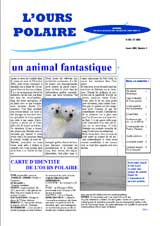
|
The Sea Museum
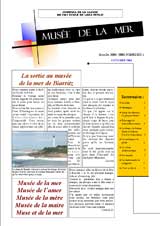
|
Art (eg: book illustration)
The illustration of the book uses various art techniques: painting, printing inks, charcoal, pen and chinese ink... It was also an opportunity to explore Inuit art and inspiration of its formsgraphics.
See the children drawings |
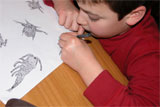
|
Synthetic posters
Biology (eg: plankton, krill, marine mammals)
Observation of organisms with a microscope.
Inventory of the various species available in the marine ecosystem. Comparative study of their characteristics.
Same approach for marine mammals, including varieties of whales.
|
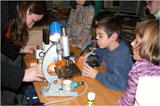
|
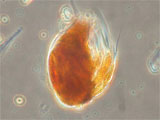
|
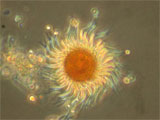
|
Ecology (eg: water cycle, carbon cycling, food web)
Study of the food web of the area.
|

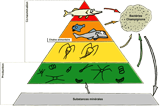
|
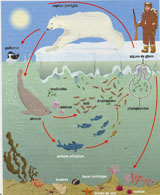
|
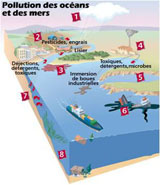
|
Physics and chemistry (eg: salinity)
A point was made on the importance of the salinity of the marine ecosystem, with its implication for freshwater and seawater, ocean currents and how they work.
Many simple experiments can be proposed in class. Eg: ice and eggs in the freshwater-seawater
|

|

|
Computing and Internet
This project required a considerable use of computers for writing and grading of text, but also for research. These searches were often conducted by teams of students, more or less important. It was imperative to get as much information as possible on given topics, in order to check and compare the data collected so their synthesis could be reliable. This constant desire to step back from any information collected on the web and develop critical thinking skills is an essential educational requirement when using Internet.
It was strongly insisted on the fact that computers and the Internet are just tools and that intelligence is the casting of people who use these tools .
|
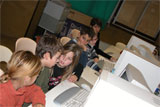
|
Mathematic (eg: consumption of the vessel)
The ship left port for a whole year and its fuel consumption depended on many factors: moving the vessel, providing energy to produce electricity, heat, water desalination... This offered the possibility to multiple calculations and math problems.
Changing temperatures was used for mathematical problems: graphics, averages, temperature ranges, trends over an entire year, cycles, seasons...
History (eg: poles discovery)
For example, a student had a passion for research on the history of the discovery of the North Pole by all explorers who embarked on the conquest of the Pole since the eighteenth century.
Retrieval library and search the web.
Geography (eg: Arctic vs. Antarctic)
Studying the poles requires changing the traditional 2-dimension representation of the world, to a 3-dimension point of view.
When, answering some questions for the children, the vessel captain suggests that a rainforest is preserved under the NorthPole, this raised the question of continental drifting and earth construction.
Another possibility in making the history and geography, is the arrival in Canada of Basque fishermen from hunting whales in the mouth of the St. Lawrence.
Studying habitats where local people live in the Arctic .
Culture (eg: lifestyle of inuits)
Economics (eg: sales of their own book)













